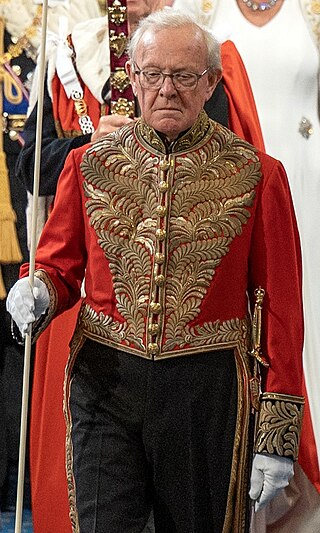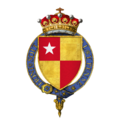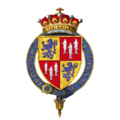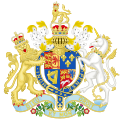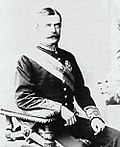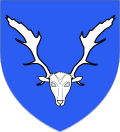Lord Great Chamberlain
Great Officer of State for England From Wikipedia, the free encyclopedia
The Lord Great Chamberlain of England[1] is the sixth of the Great Officers of State, ranking beneath the Lord Privy Seal but above the Lord High Constable. The office of Lord Great Chamberlain is an ancient one: it was first created around 1126 (in Norman times) and has been in continuous existence since 1138. The incumbent is Rupert Carington, 7th Baron Carrington.
| Lord Great Chamberlain of England | |
|---|---|
since 8 September 2022
Joint hereditary officeholders
| |
| Style | The Right Honourable |
| Type | Great Officer of State |
| Appointer | The Monarch |
| Term length | At His Majesty's pleasure |
| Formation | c. 1126 |
| First holder | Robert Malet |
| Superseded by | Lord High Treasurer (in monetary affairs) |
| Succession | Hereditary |
| Salary | Unpaid |
Duties
Summarize
Perspective

The Lord Great Chamberlain is entrusted by the Sovereign with custody of the Palace of Westminster, the seat of the British Parliament, and serves as his or her representative therein.[2] The Lord Great Chamberlain enjoys plenary jurisdiction in those precincts of the Palace of Westminster not assigned to either the House of Lords or the House of Commons: namely, the Royal Apartments, Central Lobby, and the Crypt Chapel. To this end, the Lord Great Chamberlain is responsible for the use, preservation, and occupation of such spaces.[a] In addition, the Lord Great Chamberlain is one of the three commissioners who exercise control and maintenance over Westminster Hall; the other commissioners are the Lord Speaker of the House of Lords and the Speaker of the House of Commons.[4]
The Lord Great Chamberlain performs other less routine functions as custodian of the Palace of Westminster. For example, the Lord Great Chamberlain welcomes foreign heads of state visiting the Palace of Westminster. Likewise, the Lord Great Chamberlain is responsible for attending upon the Sovereign and other members of the British royal family whenever present at the parliamentary estate. In the latter case, the Lord Great Chamberlain is authorised to make any administrative arrangements necessary for delivery of services required by the Sovereign.[5][6]
However, the Lord Great Chamberlain’s most publicly visible parliamentary role is participating in state openings of Parliament. To this end, the Lord Great Chamberlain receives the Sovereign at the Norman Porch, enrobes him or her with the Robe of State and the Imperial State Crown in the Robing Room, and leads the Sovereign’s procession through the Royal Gallery and the Prince's Chamber into the Lords Chamber.[7] It is also the Lord Great Chamberlain who, upon the command of the Sovereign, directs Black Rod to summon members of the House of Commons to attend the House of Lords for the purpose of hearing the speech from the throne.[8]
Parliamentary responsibilities aside, the Lord Great Chamberlain also has a major part to play in royal coronations, having the right to dress the monarch on coronation day and to serve the monarch water before and after the coronation banquet. Likewise, the Lord Great Chamberlain invests the monarch with the insignia of rule during the coronation service.[9][10] On state occasions like coronations, the Lord Great Chamberlain wears a distinctive scarlet court uniform and bears a gold key and a white staff as the insignia of his office.[11]
The office of Lord Great Chamberlain is distinct from the non-hereditary office of Lord Chamberlain of the Household, a position in the monarch's household. This office arose in the 14th century as a deputy of the Lord Great Chamberlain to fulfil the latter's duties in the Royal Household, but now they are quite distinct.[citation needed]
The House of Lords Act 1999 removed the automatic right of hereditary peers to sit in the House of Lords, but the Act provided that a hereditary peer exercising the office of Lord Great Chamberlain (as well as the Earl Marshal) be exempt from such a rule, in order to perform ceremonial functions.[citation needed]
Succession
The position is a hereditary one, held since 1780 in gross. At any one time, no single person actually exercises the office of Lord Great Chamberlain. The various individuals who hold fractions of the office are properly each Joint Hereditary Lord Great Chamberlain. They choose one individual of the rank of a knight or higher to be the Deputy Lord Great Chamberlain.[12][13] Under an agreement made in 1912, the right to exercise the office for a given reign rotates among three families (of the then three joint office holders) in proportion to the fraction of the office held. For instance, the Marquesses of Cholmondeley hold one-half of the office, and may therefore exercise the office or appoint a deputy every alternate reign. Whenever one of the three shares of the 1912 agreement is split further, the joint heirs of this share have to agree among each other, who should be their deputy or any mechanism to determine who of them has the right to choose a deputy.
History of the office
Summarize
Perspective

The office was originally held by Robert Malet, a son of one of the leading companions of William the Conqueror. In 1133, however, Henry I declared Malet's estates and titles forfeit, and awarded the office of Lord Great Chamberlain to Aubrey de Vere, whose son was created Earl of Oxford. Thereafter, the Earls of Oxford held the title almost continuously until 1526, with a few intermissions due to the forfeiture of some earls for treason. In 1526, however, John de Vere, 14th Earl of Oxford died, leaving his aunts as his heirs. The earldom was inherited by a more distant heir-male, his second cousin. Henry VIII then decreed that the office belonged to the Crown, and was not transmitted along with the earldom. The King appointed John de Vere, 15th Earl of Oxford to the office, but the appointment was deemed for life and was not hereditary. The family's association with the office was interrupted in 1540, when the 15th Earl died and Thomas Cromwell, the King's chief adviser, was appointed Lord Great Chamberlain.[14] After Cromwell's attainder and execution later the same year, the office passed through a few more court figures, until 1553, when it was passed back to the de Vere family to John de Vere, 16th Earl of Oxford, again as an uninheritable life appointment.[15] Later, Mary I ruled that the Earls of Oxford were indeed entitled to the office of Lord Great Chamberlain on an hereditary basis.
Thus, the sixteenth, seventeenth and eighteenth Earls of Oxford held the position on a hereditary basis until 1626, when Henry de Vere, 18th Earl of Oxford died, again leaving a distant relative as heir male, but a closer one as a female heir. The House of Lords eventually ruled that the office belonged to the heir general, Robert Bertie, 14th Baron Willoughby de Eresby, who later became Earl of Lindsey. The office remained vested in the Earls of Lindsey, who later became Dukes of Ancaster and Kesteven.
In 1779, however, Robert Bertie, 4th Duke of Ancaster and Kesteven died, leaving two sisters as female heirs, and an uncle as an heir male. The uncle became the 5th and last Duke, but the House of Lords ruled that the two sisters were jointly Lord Great Chamberlain and could appoint a Deputy to fulfil the functions of the office. The barony of Willoughby de Eresby fell into abeyance between the two sisters, but George III terminated the abeyance and granted the title to the elder sister, Priscilla Bertie, 21st Baroness Willoughby de Eresby. The office of Lord Great Chamberlain, however, was divided between Priscilla and her younger sister Georgiana. Priscilla's share was eventually split between two of her granddaughters, and has been split several more times since then. By contrast, Georgiana's share has been inherited by a single male heir each time; that individual has in each case been the Marquess of Cholmondeley, a title created for Georgiana's husband.
20th and 21st centuries

In 1902 it was ruled by the House of Lords that the then joint office holders (Gilbert Heathcote-Drummond-Willoughby, 1st Earl of Ancaster, George Cholmondeley, 4th Marquess of Cholmondeley, and Charles Wynn-Carrinton, 1st Earl Carrington, later Marquess of Lincolnshire) had to agree on a deputy to exercise the office, subject to the approval of the Sovereign. Should there be no such agreement, the Sovereign should appoint a deputy until an agreement be reached.[16]
In 1912 an agreement was reached. The office, or right to appoint the person to exercise the office, would thereafter rotate among the three joint office holders and their heirs after them, changing at the start of each successive reign. Cholmondeley and his heirs would serve in every other reign; Ancaster and Carrington would each serve once in four reigns.[17]
As the Cholmondeley share and the Ancaster share (held since 1983 by Jane Heathcote-Drummond-Willoughby, 28th Baroness Willoughby de Eresby) are not further split, each of these holders decides in his or her turn to act as Lord Great Chamberlain or to name a person who will act as Lord Great Chamberlain. The Carrington share was divided at his death among his five daughters and their heirs, and has since been further divided, with 11 people holding shares as of September 2022. At accession of Charles III the turn fell to the Carrington heirs who named their cousin Rupert Carington, 7th Baron Carrington, to act as Lord Great Chamberlain.[18][19][20] Being descended from the Earl's younger brother he himself has no share of the office.
On 6 May 2023, the Lord Great Chamberlain presented spurs to King Charles III as part of Charles' coronation. The spurs were included among the first English coronation ornaments in 1189 and were used during the coronation of Richard I.[21]
Lord Great Chamberlains, 1130–1779
Joint hereditary Lord Great Chamberlains, 1780–present
Summarize
Perspective
The fractions show the holder's share in the office, and the date they held it. The current (as of 2022[update]) holders of the office are shown in bold face.
| Joint hereditary Lord Great Chamberlains, 1780–present | |||||||||||||||||||||||||||||||||||||||||||||||||||||||||||||||||||||||||||||||||||||||||||||||||||||||||||||||||||||||||||||||||||||||||||||||||||||||||||||||||||||||||||||||||||||||||||||||||||||||||||||||||||||||||||||||||||||||||||||||||||||||||||||||||||||||||||||||||||||||||||||||||||||||||||||||||||||||||||||||||||||||||||||||||||||||||||||||||||||||||||||||||||||||||||||||||||||||||||||||||||||||||||||||||||||||||||||||||||||||||||||||||||||||||||||||||||||||||||||||||||||||||||||||||||||||||||||||||||||||||||||||||||||||||||||||||||||||||||||||||||||||||||||||||||||||||||||||||||||||||||||||||||||||||||||||||||||||||||||||||||||||||||||||||||||||||||||||||||||||||||||||||||||||||||||||||||||||||||||||||||||||||||||||||||||||||||||||||||||||||||||||||||||||||||||||||||||||||||||||||||||||||||||||||||||||||||||||||||||||||||||||||||||||||||||||||||||||||||||||||||||||||||||||||||||||||||||||||||||||||||||||||||||||||||||||||||||||||||||||||||||||||||||||||||||||||||||||||||||||
|---|---|---|---|---|---|---|---|---|---|---|---|---|---|---|---|---|---|---|---|---|---|---|---|---|---|---|---|---|---|---|---|---|---|---|---|---|---|---|---|---|---|---|---|---|---|---|---|---|---|---|---|---|---|---|---|---|---|---|---|---|---|---|---|---|---|---|---|---|---|---|---|---|---|---|---|---|---|---|---|---|---|---|---|---|---|---|---|---|---|---|---|---|---|---|---|---|---|---|---|---|---|---|---|---|---|---|---|---|---|---|---|---|---|---|---|---|---|---|---|---|---|---|---|---|---|---|---|---|---|---|---|---|---|---|---|---|---|---|---|---|---|---|---|---|---|---|---|---|---|---|---|---|---|---|---|---|---|---|---|---|---|---|---|---|---|---|---|---|---|---|---|---|---|---|---|---|---|---|---|---|---|---|---|---|---|---|---|---|---|---|---|---|---|---|---|---|---|---|---|---|---|---|---|---|---|---|---|---|---|---|---|---|---|---|---|---|---|---|---|---|---|---|---|---|---|---|---|---|---|---|---|---|---|---|---|---|---|---|---|---|---|---|---|---|---|---|---|---|---|---|---|---|---|---|---|---|---|---|---|---|---|---|---|---|---|---|---|---|---|---|---|---|---|---|---|---|---|---|---|---|---|---|---|---|---|---|---|---|---|---|---|---|---|---|---|---|---|---|---|---|---|---|---|---|---|---|---|---|---|---|---|---|---|---|---|---|---|---|---|---|---|---|---|---|---|---|---|---|---|---|---|---|---|---|---|---|---|---|---|---|---|---|---|---|---|---|---|---|---|---|---|---|---|---|---|---|---|---|---|---|---|---|---|---|---|---|---|---|---|---|---|---|---|---|---|---|---|---|---|---|---|---|---|---|---|---|---|---|---|---|---|---|---|---|---|---|---|---|---|---|---|---|---|---|---|---|---|---|---|---|---|---|---|---|---|---|---|---|---|---|---|---|---|---|---|---|---|---|---|---|---|---|---|---|---|---|---|---|---|---|---|---|---|---|---|---|---|---|---|---|---|---|---|---|---|---|---|---|---|---|---|---|---|---|---|---|---|---|---|---|---|---|---|---|---|---|---|---|---|---|---|---|---|---|---|---|---|---|---|---|---|---|---|---|---|---|---|---|---|---|---|---|---|---|---|---|---|---|---|---|---|---|---|---|---|---|---|---|---|---|---|---|---|---|---|---|---|---|---|---|---|---|---|---|---|---|---|---|---|---|---|---|---|---|---|---|---|---|---|---|---|---|---|---|---|---|---|---|---|---|---|---|---|---|---|---|---|---|---|---|---|---|---|---|---|---|---|---|---|---|---|---|---|---|---|---|---|---|---|---|---|---|---|---|---|---|---|---|---|---|---|---|---|---|---|---|---|---|---|---|---|---|---|---|---|---|---|---|---|---|---|---|---|---|---|---|---|---|---|---|---|---|---|---|---|---|---|---|---|---|---|---|---|---|---|---|---|---|---|---|---|---|---|---|---|---|---|---|---|---|---|---|---|---|---|---|---|---|---|---|---|---|---|---|---|---|---|---|---|---|---|---|---|---|---|---|---|---|---|---|---|---|---|---|---|---|---|---|---|---|---|---|---|---|---|---|---|---|---|---|---|---|---|---|---|---|---|---|---|---|---|---|---|---|---|---|---|---|---|---|---|---|---|---|---|---|---|---|---|---|---|---|---|---|---|---|---|---|---|---|---|---|---|---|---|---|---|---|---|---|---|---|---|---|---|---|---|---|---|---|---|---|---|---|---|---|---|---|---|---|---|---|---|---|---|---|---|---|---|---|---|---|---|---|---|---|---|---|---|---|---|---|---|---|---|---|---|---|---|---|---|---|---|---|---|---|---|---|---|---|---|---|---|---|---|---|---|---|---|---|---|---|---|---|---|---|---|---|---|---|---|---|---|---|---|---|---|---|---|---|---|---|---|---|---|---|---|---|---|---|---|---|---|---|---|---|---|---|---|---|---|---|---|---|---|---|---|---|---|---|---|---|---|---|---|---|---|---|---|---|---|---|---|---|---|---|---|---|---|---|---|---|---|---|---|---|---|---|---|---|---|---|---|---|---|---|---|---|---|---|---|---|---|---|---|---|---|---|---|---|---|---|---|---|---|---|---|---|---|---|---|---|---|---|---|---|---|---|---|---|---|---|---|---|---|---|---|---|---|---|---|---|---|---|---|---|---|---|---|---|---|---|---|---|---|---|---|---|---|---|---|---|---|---|---|---|---|---|---|---|---|---|---|---|---|---|---|---|---|
| |||||||||||||||||||||||||||||||||||||||||||||||||||||||||||||||||||||||||||||||||||||||||||||||||||||||||||||||||||||||||||||||||||||||||||||||||||||||||||||||||||||||||||||||||||||||||||||||||||||||||||||||||||||||||||||||||||||||||||||||||||||||||||||||||||||||||||||||||||||||||||||||||||||||||||||||||||||||||||||||||||||||||||||||||||||||||||||||||||||||||||||||||||||||||||||||||||||||||||||||||||||||||||||||||||||||||||||||||||||||||||||||||||||||||||||||||||||||||||||||||||||||||||||||||||||||||||||||||||||||||||||||||||||||||||||||||||||||||||||||||||||||||||||||||||||||||||||||||||||||||||||||||||||||||||||||||||||||||||||||||||||||||||||||||||||||||||||||||||||||||||||||||||||||||||||||||||||||||||||||||||||||||||||||||||||||||||||||||||||||||||||||||||||||||||||||||||||||||||||||||||||||||||||||||||||||||||||||||||||||||||||||||||||||||||||||||||||||||||||||||||||||||||||||||||||||||||||||||||||||||||||||||||||||||||||||||||||||||||||||||||||||||||||||||||||||||||||||||||||||
Persons exercising the office of Lord Great Chamberlain, 1780–present
Notes
- From the Restoration until 1963, the Lord Great Chamberlain was responsible for physical plant and facility management throughout the Palace of Westminster, in effect serving as a property manager for the entire parliamentary estate.[3]
References
External links
Wikiwand - on
Seamless Wikipedia browsing. On steroids.
